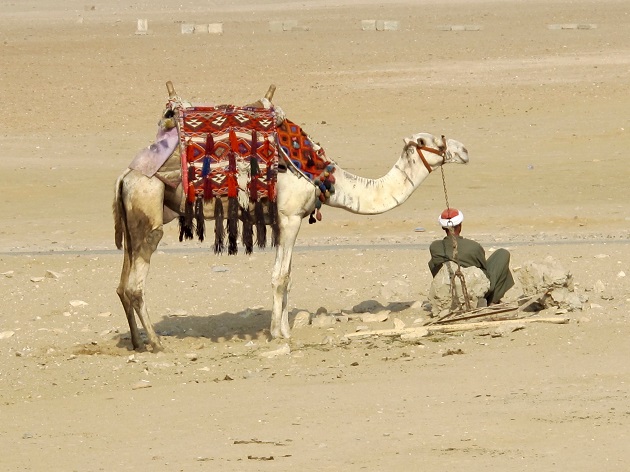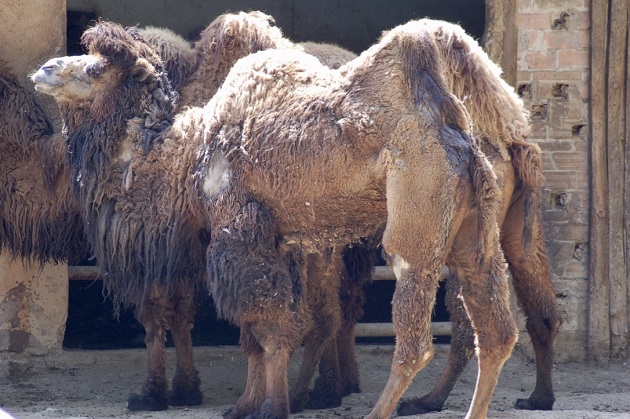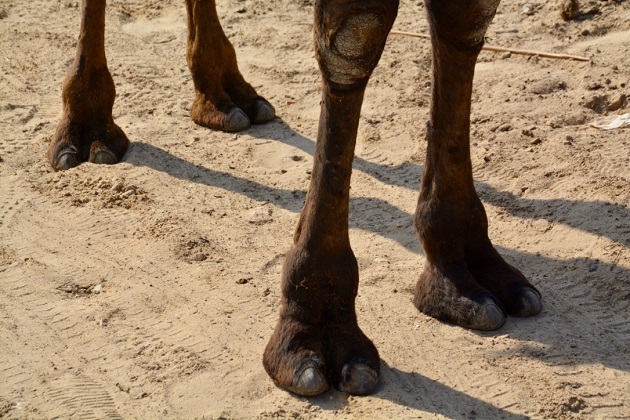They were ruminating mammals, capable of running more than a hundred kilometres without either eating or drinking. Their large feet are perfectly designed for walking across the desert sands.
 Dromedaries - Camelus dromedarius - resting next to its owner near the famous Egyptian pyramids, waiting to be hired by a tourist. The camels mentioned in the Bible would have looked like this, as they were, in fact, dromedaries.
Dromedaries - Camelus dromedarius - resting next to its owner near the famous Egyptian pyramids, waiting to be hired by a tourist. The camels mentioned in the Bible would have looked like this, as they were, in fact, dromedaries.
As they sat down to eat their meal, they looked up and saw a caravan of Ishmaelites coming from Gilead. Their camels were loaded with spices, balm and myrrh, and they were on their way to take them down to Egypt. (Gn. 37:25)
The camel is mentioned almost 70 times in the Bible. The Hebrew term used to refer to it is gamal, whereas in Aramaic it is gamala, in Greek kámelos, and in Latin camelus, from which it derived its name in West European languages. As a matter of fact, the animal mentioned in the Scriptures is the dromedarius (Camelus dromedarius), as the real camel (Camellus bactrianus) has two humps instead of one, and is native to the much colder regions of central Asia. Both species, however, have been used as a means of transport by humankind since time immemorial.
Concerning this latter point, a debate is under way among archaeologists, historians and theologians as to the period when this animal was domesticated.
The Bible situates this period at the time of the earliest Hebrew patriarchs, Abraham and Jacob, (Gen. 12v16; 30v43). Rebecca was carried on the back of a camel when she arrived to meet Isaac (Gen. 24v64). The Ishmaelites who took Joseph to Egypt used camels as beasts of burden in their travels (Gen. 37v25).This means that, according to Biblical history, dromedaries had already been domesticated by the second millennium before Christ. However, as archaeologists are generally loath to accept Biblical dating as trustworthy until backed up by evidence external to the Bible, a certain discovery unearthed in Aravá, south of the Dead Sea, cast doubt over the degree of antiquity that the Bible attributes to camels. In fact, two researchers from the University of Tel Aviv, after examining and carbon-dating the remains of camel bones found next to a complex of ancient copper mines, concluded that they dated back to the end of the 10th century before Christ. In other words, they were from a millennium later than the period of Abraham. As often happens, there soon followed tabloid-type newspaper headlines from sceptics asserting that the Bible was wrong.
However, in the interpretation of this discovery one crucially important consideration was not taken into account. The fact that the bones that were found were from the 10th century before Christ does not in any way show that there were no domesticated camels in the region before that. The absence of evidence is not evidence of absence. In other words, the fact that older remains have not been found does not prove that they did not exist. It is true that so far no organic remains of these animals dating back to the second millennium before Christ have been found, but there is evidence of their existence in Egypt. In Aswan there is an engraving from the 6th Dynasty with the image of a dromedary with its rider. This Dynasty spanned the period from 2324 BC to 2160 BC, which proves that the camel was domesticated by the 3rd millennium BC, just as the Bible implies. [2]
 Photo: The real camel - Camelus bactrianus -, like these specimens photographed at Barcelona zoo, had two large humps instead of one, and they live in the cold regions of Central Asia. They are not the species that we find in the pages of the Bible. They are thought to have been domesticated more than 4000 years ago. / Photo: Antonio Cruz
Photo: The real camel - Camelus bactrianus -, like these specimens photographed at Barcelona zoo, had two large humps instead of one, and they live in the cold regions of Central Asia. They are not the species that we find in the pages of the Bible. They are thought to have been domesticated more than 4000 years ago. / Photo: Antonio CruzLater, following the conquest of Canaan, the Hebrews became sedentary, and no longer needed the dromedary, so their use became confined to the nomadic tribes that travelled across the desert. That said, the wealthy classes still possessed animals of this kind, which they would use for their journeys across desert regions, and for the transportation of merchandise.
The Bible states that Job was the owner of a large number of camels (Job 1 v 3; 42 v 12); likewise, King David had many camels (1 Sam. 27 v 9), some of which were war-booty; the Ishmaelites were entrusted with the task of taking care of the royal camels (1 Chronicles 27 v 30); the Midianites used camels in their tribal battles (Judges 6 v 5); Cyrus also used them in warfare, with two archers riding on each animal (Isaiah 21 v 7) and, finally, being the owner of many camels was a symbol of wealth, prosperity or blessing (Isaiah 60 v 6). Without them, the development of important trade routes would not have been possible.
Dromedaries, or one-hump camelids, have their origin in the Arab Peninsula, where they can withstand temperatures of up to 50º centigrade. By contrast as has been pointed out, two-hump camels are of central Asian origin, and are adapted to living in areas with long, freezing winters, such as are common in the Gobi desert, for example. Their two humps are, undoubtedly, the clearest visible difference with respect to the dromedary. The hump is a structure primarily consisting of fatty tissue, from which they obtain energy for their lengthy journeys through inhospitable terrain with little or no vegetation. Besides, it serves to prevent excessive heat-loss during the night, or when the temperature drops sharply. That is why the camel living in cold climates has two humps. Besides, also in relation to the regions where the two species live, there is their very different hides. Cold-climate camels have long fur, which becomes very thick in winter, and which they shed in summer, while dromedaries have short hair throughout the year, which helps them to dissipate their body heat. Camels are smaller, more robust and heavier than dromedaries, their legs are shorter and more suited to frozen mountainous terrains, while dromedaries are slimmer, and their longer limbs enable them to raise their bodies higher over the burning heat of the desert sands. This adaptation prevents them from over-heating, and means that they can travel more quickly.
 Photo: Antonio Cruz
Photo: Antonio CruzThe feet of the dromedary, or the Arabian camel, are wide and only have two toes. This feature means that as they lean their weight on the ground, their feet spread out, which prevents them from sinking into the sand. Besides, the sole of each foot is covered by a thick outer layer, which protects them from the burning sand of the dunes. As they walk, they move the two feet of the same side of their bodies at the same time, and then those of the other side. This recalls the swaying movement of a ship, which is why they are called “desert ships”.
Although the Bible mentions both camels and dromedaries (Isaiah 60 v 6), in fact it is the latter that feature most frequently. They are ruminating mammals capable of covering more than a hundred kilometres without needing to eat or drink. Their long legs are perfectly designed for walking across the desert sand. They only have two toes, joined by a kind of sole cushion. Under their bellies they have a cluster of aquiferous cells, which constitute a store of metabolic water.
The temper of the dromedary is unpredictable. They are prone to outbursts of anger. They can be triggered by the slightest sudden noise, like the screech of a bird. They don’t quickly forget an injury, and can be vindictive. They have even been known to bite their owners, or to wreak havoc on a whole caravan when they lose their temper. On balance however, the benefits that they offer humankind outweigh the problems caused by their unpredictable temperament. The Israelites were forbidden to eat camel meat (Lev. 11v4; Deut. 14v7), whereas the Arabs were allowed to eat it. The hide was used to make tents and clothing. Even camel milk was one of the foundational elements of Bedouin food.
In the New Testament, the Lord Jesus refers to the camel to highlight the impossibility of certain things: “it is easier for a camel to go through the eye of a needle than for a rich man to enter the kingdom of God” (Mat. 19 v 24). He also uses it to expose the hypocrisy of the Pharisees: “Blind leaders of the blind, who strain at a gnat and swallow a camel!” (Mat. 23 v 24). In this latter sense, the 17th century theologian Nathanael Hardy wrote:
If our offenses were not like gnats but like camels, our punishment will have to be, not a glass of water, but a whole ocean. Crimson sins require tears of blood; and if Peter had to cry bitterly, it is because he sinned shamefully. Thus, if your previous life was a string of iniquities, a rope braided with threads of sin, a text replete with erasures, a torrent stained with diverse and grave transgressions: multiply your confessions, and deepen your humiliation; redouble your fasts, and triple your prayers; pour out your tears and emit deep sighs. In brief, increase your repentance and humiliation, though do so wisely and with moderation, because, as the apostle says in another passage of Scripture: “Do not grieve as those with no hope”, because you can count on the full assurance that upon your sincere and appropriate repentance, divine goodness will forgive, without exception, all the sins you have committed. [3]
[2] https://es.wikipedia.org/wiki/Dinastía_VI_de_Egipto
[3] Hardy, N. en Spurgeon, C. H. 2015, El Tesoro de David, CLIE, p. 809-810.

Las opiniones vertidas por nuestros colaboradores se realizan a nivel personal, pudiendo coincidir o no con la postura de la dirección de Protestante Digital.
Si quieres comentar o